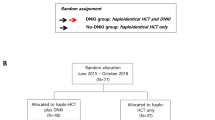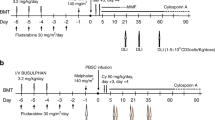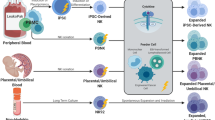Abstract
We report a novel phase 2 clinical trial in patients with poor prognosis refractory non-Hodgkin lymphoma (NHL) testing the efficacy of haploidentical donor natural killer (NK) cell therapy (NK dose 0.5–3.27 × 107 NK cells/kg) with rituximab and IL-2 (clinicaltrials.gov NCT01181258). Therapy was tolerated without graft-versus-host disease, cytokine release syndrome, or neurotoxicity. Of 14 evaluable patients, 4 had objective responses (29%; 95% CI 12–55%) at 2 months: 2 had complete response lasting 3 and 9 months. Circulating donor NK cells persisted for at least 7 days after infusion at the level 0.6–16 donor NK cells/µl or 0.35–90% of total CD56 cells. Responding patients had lower levels of circulating host-derived Tregs (17 ± 4 vs. 307 ± 152 cells/µL; p = 0.008) and myeloid-derived suppressor cells at baseline (6.6 ± 1.4% vs. 13.0 ± 2.7%; p = 0.06) than non-responding patients. Lower circulating Tregs correlated with low serum levels of IL-10 (R 2 = 0.64; p < 0.003; n = 11), suggestive of less immunosuppressive milieu. Low expression of PD-1 on recipient T cells before therapy was associated with response. Endogenous IL-15 levels were higher in responders than non-responding patients at the day of NK cell infusion (mean ± SEM: 30 ± 4; n = 4 vs. 19.0 ± 4.0 pg/ml; n = 8; p = 0.02) and correlated with day 14 NK cytotoxicity as measured by expression of CD107a (R 2 = 0.74; p = 0.0009; n = 12). In summary, our observations support development of donor NK cellular therapies for advanced NHL as a strategy to overcome chemoresistance. Therapeutic efficacy may be further improved through disruption of the immunosuppressive environment and infusion of exogenous IL-15.





Similar content being viewed by others
Abbreviations
- ACL:
-
Absolute lymphocyte cell
- ADCC:
-
Antibody-dependent cell-mediated cytotoxicity
- AML:
-
Acute myeloid leukemia
- ASH:
-
American Society of Hematology
- CD:
-
Cluster of differentiation
- CT:
-
Computed tomography
- CTCAE:
-
Common terminology criteria for adverse events
- FDR:
-
False-discovery rate
- IFN-γ:
-
Interferonγ
- IRB:
-
Institutional Review Board
- ITIM:
-
Immunoreceptor tyrosine-based inhibition motif
- KIR:
-
Killer cell immunoglobulin-like receptor
- KPS:
-
Karnofsky performance status
- MDSC:
-
Myeloid-derived suppressor cell
- NCI:
-
National Cancer Institute
- NHL:
-
Non-Hodgkin lymphoma
- NK:
-
Natural killer
- PB:
-
Peripheral blood
- PBMC:
-
Peripheral blood mononuclear cells
- PCR:
-
Polymerase chain reaction
- PET:
-
Positron emission tomography
- PRA:
-
Panel reactive antibody
- TIGIT:
-
T cell immunoreceptor with Ig and ITIM domains
- TIM-3:
-
T cell immunoglobulin mucin-3
- TNC:
-
Total nuclear cell
- TNFα:
-
Tumor necrosis factorα
- Treg:
-
Regulator T cells
- VNTR:
-
Very short tandem repeat
- WB:
-
Whole blood
References
Van Den Neste E, Schmitz N, Mounier N, Gill D, Linch D, Trneny M, Bouadballah R, Radford J, Bargetzi M, Ribrag V, Duhrsen U, Ma D, Briere J, Thieblemont C, Bachy E, Moskowitz CH, Glass B, Gisselbrecht C (2017) Outcomes of diffuse large B-cell lymphoma patients relapsing after autologous stem cell transplantation: an analysis of patients included in the CORAL study. Bone Marrow Transplant 52(2):216–221. https://doi.org/10.1038/bmt.2016.213https://doi.org/
Kochenderfer JN, Dudley ME, Kassim SH, Somerville RP, Carpenter RO, Stetler-Stevenson M, Yang JC, Phan GQ, Hughes MS, Sherry RM, Raffeld M, Feldman S, Lu L, Li YF, Ngo LT, Goy A, Feldman T, Spaner DE, Wang ML, Chen CC, Kranick SM, Nath A, Nathan DA, Morton KE, Toomey MA, Rosenberg SA (2015) Chemotherapy-refractory diffuse large B-Cell lymphoma and indolent B-cell malignancies can be effectively treated with autologous T cells expressing an anti-CD19 chimeric antigen receptor. J Clin Oncol 33(6):540–549. https://doi.org/10.1200/JCO.2014.56.2025
Fowler NH, Cheah CY, Gascoyne RD, Gribben J, Neelapu SS, Ghia P, Bollard C, Ansell S, Curran M, Wilson WH, O’Brien S, Grant C, Little R, Zenz T, Nastoupil LJ, Dunleavy K (2016) Role of the tumor microenvironment in mature B-cell lymphoid malignancies. Haematologica 101(5):531–540. https://doi.org/10.3324/haematol.2015.139493
Benson DM Jr, Bakan CE, Mishra A, Hofmeister CC, Efebera Y, Becknell B, Baiocchi RA, Zhang J, Yu J, Smith MK, Greenfield CN, Porcu P, Devine SM, Rotem-Yehudar R, Lozanski G, Byrd JC, Caligiuri MA (2010) The PD-1/PD-L1 axis modulates the natural killer cell versus multiple myeloma effect: a therapeutic target for CT-011, a novel monoclonal anti-PD-1 antibody. Blood 116(13):2286–2294. https://doi.org/10.1182/blood-2010-02-271874
Bachanova V, Burns LJ, McKenna DH, Curtsinger J, Panoskaltsis-Mortari A, Lindgren BR, Cooley S, Weisdorf D, Miller JS (2010) Allogeneic natural killer cells for refractory lymphoma. Cancer Immunol Immunother 59(11):1739–1744. https://doi.org/10.1007/s00262-010-0896-z
Murphy WJ, Parham P, Miller JS (2012) NK cells–from bench to clinic. Biol Blood Marrow Transplant 18(1Suppl):2–7. https://doi.org/10.1016/j.bbmt.2011.10.033
Knorr DA, Bachanova V, Verneris MR, Miller JS (2014) Clinical utility of natural killer cells in cancer therapy and transplantation. Semin Immunol 26(2):161–172. https://doi.org/10.1016/j.smim.2014.02.002
McKenna DH, Kadidlo DM, Miller JS, Orchard PJ, Wagner JE, McCullough J (2005) The Minnesota molecular and cellular therapeutics facility: a state-of-the-art biotherapeutics engineering laboratory. Transfus Med Rev 19(3):217–228
Cheson BD, Fisher RI, Barrington SF, Cavalli F, Schwartz LH et al (2014) Recommendations for initial evaluation, staging, and response assessment of Hodgkin and non-Hodgkin lymphoma: the Lugano classification. J Clin Oncol 32(27):3059–3068. https://doi.org/10.1200/JCO.2013.54.8800
Benjamini Y, Hochberg Y (1995) Controlling the false discovery rate—a practical and powerful approach to multiple testing. J R Stat Soc B Met 57:289–300
Koyama S, Akbay EA, Li YY, Herter-Sprie GS, Buczkowski KA, Richards WG, Gandhi L, Redig AJ, Rodig SJ, Asahina H, Jones RE, Kulkarni MM, Kuraguchi M, Palakurthi S, Fecci PE, Johnson BE, Janne PA, Engelman JA, Gangadharan SP, Costa DB, Freeman GJ, Bueno R, Hodi FS, Dranoff G, Wong KK, Hammerman PS (2016) Adaptive resistance to therapeutic PD-1 blockade is associated with upregulation of alternative immune checkpoints. Nat Commun 7:10501. https://doi.org/10.1038/ncomms10501
Anderson AC, Joller N, Kuchroo VK (2016) Lag-3, Tim-3, and TIGIT: co-inhibitory receptors with specialized functions in immune regulation. Immunity 44(5):989–1004. https://doi.org/10.1016/j.immuni.2016.05.001https://doi.org/
Gleason MK, Lenvik TR, McCullar V, Felices M, O’Brien MS, Cooley SA, Verneris MR, Cichocki F, Holman CJ, Panoskaltsis-Mortari A, Niki T, Hirashima M, Blazar BR, Miller JS (2012) Tim-3 is an inducible human natural killer cell receptor that enhances interferon gamma production in response to galectin-9. Blood 119(13):3064–3072. https://doi.org/10.1182/blood-2011-06-360321
Yang ZZ, Grote DM, Ziesmer SC, Xiu B, Novak AJ, Ansell SM (2015) PD-1 expression defines two distinct T-cell sub-populations in follicular lymphoma that differentially impact patient survival. Blood Cancer J 5:e281. https://doi.org/10.1038/bcj.2015.1
Yang ZZ, Liang AB, Ansell SM (2015) T-cell-mediated antitumor immunity in B-cell non-Hodgkin lymphoma: activation, suppression and exhaustion. Leuk Lymphoma 56(9):2498–2504. https://doi.org/10.3109/10428194.2015.1011640
Kiaii S, Clear AJ, Ramsay AG, Davies D, Sangaralingam A, Lee A, Calaminici M, Neuberg DS, Gribben JG (2013) Follicular lymphoma cells induce changes in T-cell gene expression and function: potential impact on survival and risk of transformation. J Clin Oncol 31(21):2654–2661. https://doi.org/10.1200/JCO.2012.44.2137
Joller N, Hafler JP, Brynedal B, Kassam N, Spoerl S, Levin SD, Sharpe AH, Kuchroo VK (2011) Cutting edge: TIGIT has T cell-intrinsic inhibitory functions. J Immunol 186(3):1338–1342. https://doi.org/10.4049/jimmunol.1003081
Wang F, Hou H, Wu S, Tang Q, Liu W, Huang M, Yin B, Huang J, Mao L, Lu Y, Sun Z (2015) TIGIT expression levels on human NK cells correlate with functional heterogeneity among healthy individuals. Eur J Immunol 45(10):2886–2897. https://doi.org/10.1002/eji.201545480
Kong Y, Zhu L, Schell TD, Zhang J, Claxton DF, Ehmann WC, Rybka WB, George MR, Zeng H, Zheng H (2016) T-cell immunoglobulin and ITIM domain (TIGIT) associates with CD8 + T-cell exhaustion and poor clinical outcome in AML patients. Clin Cancer Res 22(12):3057–3066. https://doi.org/10.1158/1078-0432.CCR-15-2626
Sarhan D, Cichocki F, Zhang B, Yingst A, Spellman SR, Cooley S, Verneris MR, Blazar BR, Miller JS (2016) Adaptive NK cells with low TIGIT expression are inherently resistant to myeloid-derived suppressor cells. Cancer Res 76(19):5696–5706. https://doi.org/10.1158/0008-5472.CAN-16-0839
Bachanova V, Cooley S, Defor TE, Verneris MR, Zhang B, McKenna DH, Curtsinger J, Panoskaltsis-Mortari A, Lewis D, Hippen K, McGlave P, Weisdorf DJ, Blazar BR, Miller JS (2014) Clearance of acute myeloid leukemia by haploidentical natural killer cells is improved using IL-2 diphtheria toxin fusion protein. Blood 123(25):3855–3866. https://doi.org/10.1182/blood-2013-10-532531
Liew FY, McInnes IB (2002) Role of interleukin 15 and interleukin 18 in inflammatory response. Ann Rheum Dis 61(Suppl2):ii100–i102
Miller JS, Oelkers S, Verfaillie C, McGlave P (1992) Role of monocytes in the expansion of human activated natural killer cells. Blood 80(9):2221–2229
Lapteva N, Durett AG, Sun J, Rollins LA, Huye LL, Fang J, Dandekar V, Mei Z, Jackson K, Vera J, Ando J, Ngo MC, Coustan-Smith E, Campana D, Szmania S, Garg T, Moreno-Bost A, Vanrhee F, Gee AP, Rooney CM (2012) Large-scale ex vivo expansion and characterization of natural killer cells for clinical applications. Cytotherapy 14(9):1131–1143. https://doi.org/10.3109/14653249.2012.700767
Shah N, Li L, McCarty J, Kaur I, Yvon E, Shaim H, Muftuoglu M, Liu E, Orlowski RZ, Cooper L, Lee D, Parmar S, Cao K, Sobieiski C, Saliba R, Hosing C, Ahmed S, Nieto Y, Bashir Q, Patel K, Bollard C, Qazilbash M, Champlin R, Rezvani K, Shpall EJ (2017) Phase I study of cord blood-derived natural killer cells combined with autologous stem cell transplantation in multiple myeloma. Br J Haematol 177(3):457–466. https://doi.org/10.1111/bjh.14570
Rubnitz JE, Inaba H, Ribeiro RC, Pounds S, Rooney B, Bell T, Pui CH, Leung W (2010) NKAML: a pilot study to determine the safety and feasibility of haploidentical natural killer cell transplantation in childhood acute myeloid leukemia. J Clin Oncol 28(6):955–959. https://doi.org/10.1200/JCO.2009.24.4590https://doi.org/
Miller JS, Rooney CM, Curtsinger J, McElmurry R, McCullar V, Verneris MR, Lapteva N, McKenna D, Wagner JE, Blazar BR, Tolar J (2014) Expansion and homing of adoptively transferred human natural killer cells in immunodeficient mice varies with product preparation and in vivo cytokine administration: implications for clinical therapy. Biol Blood Marrow Transplant 20(8):1252–1257. https://doi.org/10.1016/j.bbmt.2014.05.004
Ayello J, van de Ven C, Fortino W, Wade-Harris C, Satwani P, Baxi L, Simpson LL, Sanger W, Pickering D, Kurtzberg J, Cairo MS (2006) Characterization of cord blood natural killer and lymphokine activated killer lymphocytes following ex vivo cellular engineering. Biol Blood Marrow Transplant 12(6):608–622. https://doi.org/10.1016/j.bbmt.2006.01.009
Vasu S, Berg M, Davidson-Moncada J, Tian X, Cullis H, Childs RW (2015) A novel method to expand large numbers of CD56(+) natural killer cells from a minute fraction of selectively accessed cryopreserved cord blood for immunotherapy after transplantation. Cytotherapy 17(11):1582–1593. https://doi.org/10.1016/j.jcyt.2015.07.020
Li H, Han Y, Guo Q, Zhang M, Cao X (2009) Cancer-expanded myeloid-derived suppressor cells induce anergy of NK cells through membrane-bound TGF-beta 1. J Immunol 182(1):240–249
Mao Y, Sarhan D, Steven A, Seliger B, Kiessling R, Lundqvist A (2014) Inhibition of tumor-derived prostaglandin-e2 blocks the induction of myeloid-derived suppressor cells and recovers natural killer cell activity. Clin Cancer Res 20(15):4096–4106. https://doi.org/10.1158/1078-0432.CCR-14-0635
Tadmor T, Fell R, Polliack A, Attias D (2013) Absolute monocytosis at diagnosis correlates with survival in diffuse large B-cell lymphoma-possible link with monocytic myeloid-derived suppressor cells. Hematol Oncol 31(3):65–71. https://doi.org/10.1002/hon.2019
Azzaoui I, Uhel F, Rossille D, Pangault C, Dulong J, Le Priol J, Lamy T, Houot R, Le Gouill S, Cartron G, Godmer P, Bouabdallah K, Milpied N, Damaj G, Tarte K, Fest T, Roussel M (2016) T-cell defect in diffuse large B-cell lymphomas involves expansion of myeloid-derived suppressor cells. Blood 128(8):1081–1092. https://doi.org/10.1182/blood-2015-08-662783
Schlecker E, Stojanovic A, Eisen C, Quack C, Falk CS, Umansky V, Cerwenka A (2012) Tumor-infiltrating monocytic myeloid-derived suppressor cells mediate CCR5-dependent recruitment of regulatory T cells favoring tumor growth. J Immunol 189(12):5602–5611. https://doi.org/10.4049/jimmunol.1201018
Gleason MK, Ross JA, Warlick ED, Lund TC, Verneris MR, Wiernik A, Spellman S, Haagenson MD, Lenvik AJ, Litzow MR, Epling-Burnette PK, Blazar BR, Weiner LM, Weisdorf DJ, Vallera DA, Miller JS (2014) CD16xCD33 bispecific killer cell engager (BiKE) activates NK cells against primary MDS and MDSC CD33 + targets. Blood 123(19):3016–3026. https://doi.org/10.1182/blood-2013-10-533398
Acknowledgements
We would like to thank patients and families participating in this clinical study and clinical trial office personnel, particularly research nurse Dixie Lewis, RN, for her devotion to the patients. We also thank English editor Michael Franklin.
Funding
Research reported in this publication was supported by NIH Grant P30 CA77598 utilizing the Biostatistics and Bioinformatics Core and the Translational Therapy Laboratory shared resources of the Masonic Cancer Center, University of Minnesota and by the National Center for Advancing Translational Sciences of the National Institutes of Health Award Number UL1TR000114. This work was also supported by American Society of Hematology Scholar Award (Veronika Bachanova), P01 CA65493, P01 CA111412, R01 CA72669.
Author information
Authors and Affiliations
Corresponding author
Ethics declarations
Conflict of interest
Eisai Inc has provided denileukin diftitox for this trial and supported the correlative assays. Veronika Bachanova receives funding from GT Biopharma Inc, Novartis and serves on advisory board for Seattle-Genetics. Other authors have no relevant conflicts of interest to report. The content is solely the responsibility of the authors and does not necessarily represent the official views of the National Institutes of Health.
Additional information
Note on previous publication: published as a poster at American Society of Hematology (ASH), Dec 8–12, 2016, San Diego, CA, USA. Blood 2016 128:3030 and at the 14th International Conference on Malignant Lymphoma, Palazzo dei Congressi, Lugano, Switzerland, 14–17 June, 2017. Hematological Oncology Volume 35, Issue Supplement S2; 261–62.
Electronic supplementary material
Below is the link to the electronic supplementary material.
Rights and permissions
About this article
Cite this article
Bachanova, V., Sarhan, D., DeFor, T.E. et al. Haploidentical natural killer cells induce remissions in non-Hodgkin lymphoma patients with low levels of immune-suppressor cells. Cancer Immunol Immunother 67, 483–494 (2018). https://doi.org/10.1007/s00262-017-2100-1
Received:
Accepted:
Published:
Issue Date:
DOI: https://doi.org/10.1007/s00262-017-2100-1




